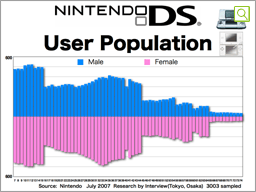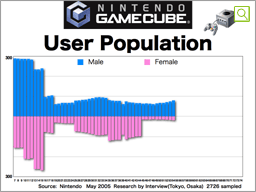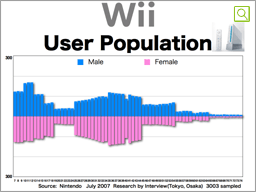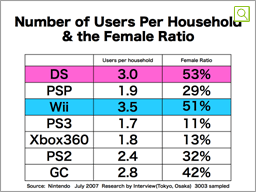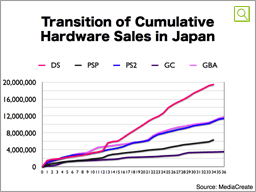It's just like this. To tell you the truth, there is one difference-in the research that you saw before, we gathered people who were 64 years old or younger. Noticing that it was not enough to cover the actual total market, we are now inviting respondents up to the age of 74. Of course, the sheer installed base of DS had already exceeded 18 million by that time, so it is natural to see the total size of the user base expanded. You can also notice that DS has users in any and all of the age demographics. The ratio of female users reached an impressive 53%.
Now, when we look at home console hardware, this chart shows the ages and genders of our customers for NINTENDO GAMECUBE about 2 and half years ago. We have altered the scaling of the vertical line a bit from the previous graphs. Once again, you can see that core users exist in younger age groups. As a result, Nintendo platforms in the days of GAMECUBE and Game Boy Advance were said to be for children.
In July this year, Wii users looked like this. The Wii's installed base was just around 3 million then, but Wii was already accepted by people in many age demographics, more so than the days of GAMECUBE, and its core users were not confined to the very young. As with DS, the share of female users was more than 50%, or 51% to be more exact.
One other thing we are researching is how many people are using game hardware within a household. In other words, we are looking at the "User Number per Household" for each machine. Here, DS and Wii show a substantial change. In the past, the number of users per household was 2.2 to 2.8 for a home console machine, and around 2.0 for a portable machine. But now, Wii has an average of 3.5 users and DS has 3.0 users, both of which are record highs in the history of video games. And given the fact that this sample includes a number of households with only one resident, we can understand that, in many other households, all members of the family are playing with DS and Wii This has a significant correlation with the high ratio of female users. The fact that female users in a wide range of age demographics have supported Nintendo platforms has greatly contributed to expanding the gaming population and, thus, helped lead to the rejuvenation of the game market.
This graph shows the transition in cumulative hardware sales dating from their launches. As you can see, DS, beginning with its 2nd year on the market, has been constantly showing an overwhelming sales rate that typically can be found on other platforms only during the year-end sales season. DS has been selling virtually irrespective of seasonality, with record speed that no other machine in the past could match. We can look at this aspect from the perspective of user expansion. When we launched DS, it was typical that potential customers asked someone in the family to purchase DS for them as a gift, during a sales season or around the turn of the year, or school vacation times in spring and summer. However, with the shift of DS core users from lower-aged groups alone to much wider and older demographics, those who want to purchase a DS can now afford to buy it for themselves whenever they feel like doing so. Also, the growing number of users in a household means that more and more people in families now think DS is something relevant to them. To put it another way, fewer and fewer people oppose the idea of purchasing a game machine. These two things have brought about this big change, we believe.
